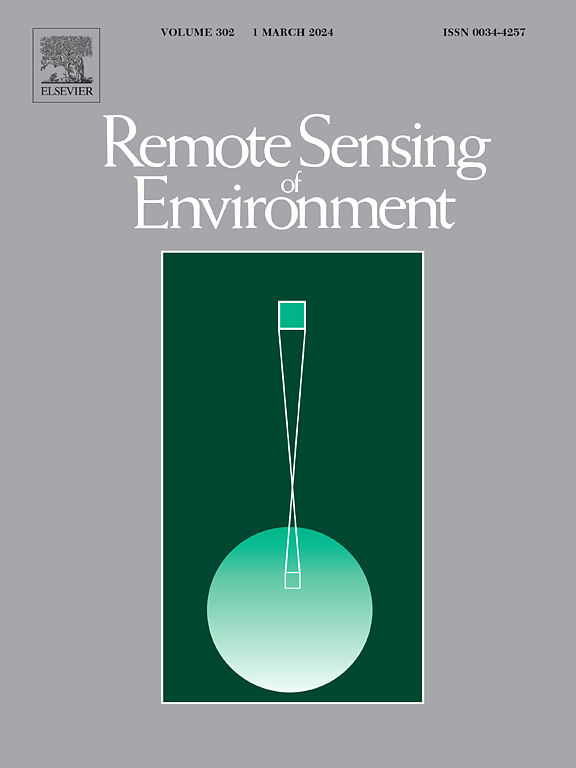在整个海洋环境中使用漂变雷达和高频雷达校正和验证Sentinel-1 IW径向速度产品
IF 11.4
1区 地球科学
Q1 ENVIRONMENTAL SCIENCES
引用次数: 0
摘要
自2014年Sentinel-1合成孔径雷达(SAR)发射以来,干涉测量宽幅(IW)模式Level-2径向速度(RVL)产品被广泛应用于海岸带精细海流(OSC)测绘。然而,RVL产品的应用受到非地球物理误差和风波诱发伪面速度误差的限制。以往的研究主要集中在提高当前海岸带的检索精度,而忽视了开阔海域,不确定性分析不足。为了解决这些问题,提出了一种同时适用于沿海和远海的非地球物理校正方案,该方案考虑了SAR场景内的陆地覆盖范围。校正后的RVL产品使用从美国东海岸、西海岸和夏威夷群岛收集的1282个漂移器和78,054个HF雷达点进行验证,显示整体精度提高超过60%。为了研究不同海况(纯风浪、风浪主导混合海、涌浪主导混合海和纯涌浪)下WASV校正的影响,利用2018年1月至2019年5月收集的127,534个匹配点,对4种校正方案的效果进行了评估。这些包括CDOP、带风和涌浪输入的KaDOP、带风和风海输入的KaDOP以及CDOP- yn。与高频雷达流综合比较表明,CDOP在纯风浪海(RMSE可达0.34 m/s)中表现较差,而结合海况参数提高了反演精度。KaDOP与CDOP-Yn的性能相当,而KaDOP在纯风或风浪为主的混合海中表现更好,RMSE为0.21 m/s,相关系数(r)为0.62。sar导出电流与原位电流之间的相关性也随入射角、卫星轨迹和极化而变化。这些结果为中尺度和亚中尺度海洋动力学研究提供了可靠的盐含量数据。本文章由计算机程序翻译,如有差异,请以英文原文为准。
Correction and validation of Sentinel-1 IW radial velocity products using drifter and HF radar across the entire ocean environment
Since Sentinel-1 synthetic aperture radar (SAR) was launched in 2014, Interferometric Wide swath (IW) mode Level-2 radial velocity (RVL) products have been widely used to map fine-scale ocean surface current (OSC) in coastal zones. However, RVL product applications are restricted by non-geophysical and Wind-wave Induced Artifact Surface Velocity (WASV) errors. Previous studies have focused on improving the current retrieval accuracy in coastal zones, while neglecting open ocean regions and insufficient uncertainty analysis. To address these issues, a non-geophysical correction scheme suitable for both coastal and open sea is proposed by considering land coverage within SAR scenes. Corrected RVL products are validated using 1282 drifters and 78,054 HF radar points collected from the U.S. East Coast, West Coast, and Hawaiian Islands, showing overall accuracy improvements exceeding 60 %. To investigate the impact of WASV correction under different sea states (e.g. pure wind wave, wind wave dominant mix sea, swell dominant mix sea, and pure swell), a total of 127,534 matching points collected from January 2018 to May 2019 are used to assess the performance of four correction schemes. These include CDOP, KaDOP with wind and swell inputs, KaDOP with wind and wind-sea inputs, and CDOP-Yn. A comprehensive comparison with HF radar current reveals that CDOP performs poorly in pure wind wave sea (RMSE up to 0.34 m/s), while incorporating sea state parameters enhances the retrieval accuracy. KaDOP and CDOP-Yn yield comparable performance, while KaDOP performs better in pure wind or wind wave dominant mix sea, achieving RMSE of 0.21 m/s and a correlation coefficient (r) of 0.62. The correlation between SAR-derived and in-situ currents also varies with incidence angle, satellite track, and polarization. Overall, these results provide reliable OSC data for mesoscale and sub-mesoscale ocean dynamics research.
求助全文
通过发布文献求助,成功后即可免费获取论文全文。
去求助
来源期刊

Remote Sensing of Environment
环境科学-成像科学与照相技术
CiteScore
25.10
自引率
8.90%
发文量
455
审稿时长
53 days
期刊介绍:
Remote Sensing of Environment (RSE) serves the Earth observation community by disseminating results on the theory, science, applications, and technology that contribute to advancing the field of remote sensing. With a thoroughly interdisciplinary approach, RSE encompasses terrestrial, oceanic, and atmospheric sensing.
The journal emphasizes biophysical and quantitative approaches to remote sensing at local to global scales, covering a diverse range of applications and techniques.
RSE serves as a vital platform for the exchange of knowledge and advancements in the dynamic field of remote sensing.
 求助内容:
求助内容: 应助结果提醒方式:
应助结果提醒方式:


